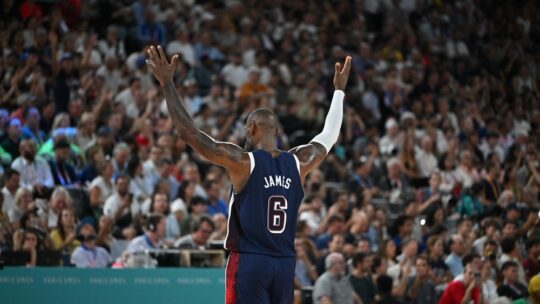
In sports, numbers are the currency—but emotion is the value.
From box scores to analytics dashboards, data drives decisions. But when it comes to driving loyalty, passion and lifelong fandom, numbers alone don’t cut it. What sticks with people, what gives them goosebumps, is the story behind the stat.
That’s where great sports communications sets itself apart. It’s not just about reporting performance metrics; it’s about transforming them into moments of meaning. A player drops 34 points? Impressive. He does it two days after welcoming a newborn daughter and dedicates the win to her? Unforgettable.
On social media, statistics might inform, but storytelling creates connection. Smart communicators don’t stop at the data; they use it as a springboard to craft narratives that resonate, inspire and build brand affinity. Here’s how to approach it:
Contextualize the Numbers
- A record is just a number until you explain what it took to get there—years of training, career-threatening injuries, sacrifices off the field.
- Example: When LeBron James broke the NBA’s all-time scoring record, the headline number 38,388 points was just the beginning. Media outlets didn’t simply report the stat; they told the story behind it, two decades of dominance, reinvention and resilience. The Lakers amplified the moment with a powerful video featuring his family, highlighting the personal journey behind the achievement, the highs, the setbacks, and everything in between. That’s the power of contextualizing a statistic: transforming a number into a narrative that resonates emotionally and cements a legacy in the hearts of fans.
Build Underdog Narratives
- Stats like “Started the season 2–10” become gripping when followed with “... and still made the playoffs.” That’s momentum, resilience and comeback energy that fans (and brands) rally behind.
- Example: A standout example is Jalen Hurts of the Philadelphia Eagles. After his Super Bowl appearance, he partnered with Jordan Brand to release a powerful video that didn’t just celebrate the win; it told the story behind it. The video highlights his journey from being overlooked and heavily criticized early in his career to becoming one of the league’s most respected quarterbacks. It’s not just about the stats or the trophy, it’s about the quiet perseverance, the doubters he silenced and the growth that got him there. That’s the kind of narrative that turns numbers into inspiration and builds real emotional connection with fans.
Highlight Progress, not Just Results
- Growth stories resonate. “He went from 25% to 42% shooting this season.” That’s more than improvement; it’s a testament to dedication. It signals effort, grit and potential, values any brand would be proud to associate with.
- Example: Kofi Kingston’s 2019 WWE Championship win was the powerful culmination of years spent overcoming under-appreciation and achieving team success with The New Day. WWE framed this milestone by highlighting key stats, such as his decade-long career and numerous tag team titles, to craft a compelling narrative of perseverance, resilience and breaking through barriers.
Tie in Personal Moments
- Use stats as a lens to highlight life milestones, emotions, or challenges that make the achievement feel human. That’s where the real connection happens.
- Example: Simone Biles on Instagram shares stats alongside personal stories, whether about her mental health struggles, family moments or life milestones, humanizing her achievements.
Why This Matters for Brands
Brand storytelling isn’t just creative, it’s strategic. Sponsoring sports brands isn’t just about logo placement or media value. It’s about alignment with identity, values and emotion. Storytelling turns sponsorship into a relationship. It creates brand moments that fans care about.
Imagine a social post from Great Clips highlighting a player’s pregame haircut ritual for good luck, or a DIRECTV campaign that frames its sports content as a place to watch human stories unfold in real time. These tactics go above and beyond the typical sports highlights and stats. They have the power to connect on an authentic level with the audience.
In short: storytelling deepens brand relevance. It shows you're not just paying to be in the room; you understand why the room matters.
How To Integrate Sports in Your Social Strategy
If your brand is involved in sports sponsorships, storytelling should be a constant rhythm in your content calendar, not a one-off campaign. Here’s how you can activate in daily or weekly touchpoints:
- Sponsored athlete content: Work with athletes to surface behind-the-scenes stories, training, family, rituals and adversity that reflect your brand’s voice and values.
- Example: Nike Women – “You Can’t Win, So Win." Nike’s 2024 “You Can’t Win, So Win” campaign was a bold and defiant celebration of women athletes who rise in the face of doubt, criticism and systemic bias. It flipped the negative commentary often directed at women in sports — “too emotional,” “too confident,” “too strong” — into empowering affirmations of strength, resilience and excellence.
- Fan engagement: Invite fans to share their personal stories tied to games, wins, losses or athletes. Create branded spaces where emotion meets community.
- Example: Gatorade's #Game6Live Campaign. In 2020, Gatorade partnered with the NBA to livestream Game 6 of the 1998 NBA Finals, allowing fans to relive the iconic game. The campaign included branded emojis and live interactions with basketball stars like Sue Bird and Zach LaVine, fostering a sense of community and nostalgia among fans.
- Moment’s marketing: Be ready to act when a story breaks, such as with record-breaking stats, a comeback win or player retirement. Respond not just with data, but with emotion that echoes fan sentiment.
- Example: Gatorade's Tribute to Serena Williams' Retirement. Upon Serena Williams' retirement announcement, Gatorade released a heartfelt ad narrated by Beyoncé, celebrating Serena's legacy and impact. The campaign was launched in conjunction with the U.S. Open, demonstrating Gatorade's timely response to a significant moment in sports.
- Game-day posts: Don’t just post final scores. Add emotional texture: “After missing last season due to injury, she dropped 20 tonight and led the comeback win.”
- Example: College Football Game-Day posts. College football programs understand how to emotionally activate their fan bases on game days. The Florida Gators are a standout example. They regularly publish content that blends behind-the-scenes visuals, slow-motion highlight reels and emotionally resonant captions. On November 16, 2024, after the Gators defeated LSU, Florida’s football team posted a highlight reel with the caption:
“Still remember the words, Coach? 🐊”
This wasn’t just a post; it was a statement. A subtle jab at LSU Head Coach Brian Kelly, who had previously mocked Florida’s tradition of playing their fourth-quarter anthem. The post turned into more than a celebration; it became a rallying point. Fans didn’t just cheer the win; they connected with the deeper narrative: defying expectations, standing united, and silencing critics with performance, not words.
- Highlight reels: Pair visuals with captions that frame the story, not just the play. “What does this win mean for you after missing the playoffs last year? Everything.”
- Example: Tyrese Haliburton’s Game Winner in the NBA Finals. This moment was captured in a highlight reel that not only showcased Haliburton's skill but also framed the shot within the context of the game's narrative, a dramatic comeback from a 15-point deficit. The storytelling aspect emphasized the significance of the moment, highlighting Haliburton's poise under pressure and the team's resilience.
Big brands are already doing this masterfully. Nike weaves performance with purpose, emotion and identity. Netflix’s "Drive to Survive" series turned cold Formula 1 stats into high-stakes human drama. The WNBA continually elevates its athletes by sharing their journeys, struggles and triumphs, not just their stat sheets. In sports marketing and communications, stats give you the structure. But storytelling? That’s what gives you soul.
If you want to earn more than clicks, if you're aiming to earn trust, loyalty, and long-term fandom, don’t just report what happened. Tell fans why it matters. That’s where brand love is built.
Anthony Storm is Social Media Community Manager at TruePoint.
